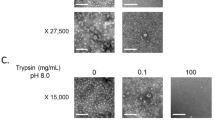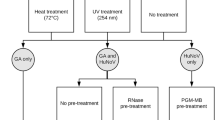Abstract
Human noroviruses (NoVs) are a major source of foodborne illnesses worldwide. Since human NoVs cannot be cultured in vitro, methods that discriminate infectious from non-infectious NoVs are needed. The purpose of this study was to evaluate binding of NoV genotypes GI.1 and GII.4 to histo-blood group antigens expressed in porcine gastric mucin (PGM) as a surrogate for detecting infectious virus following thermal (99 °C/5 min), 70 % ethanol or 0.5 % levulinic acid (LV) plus 0.01 or 0.1 % sodium dodecyl sulfate (SDS) sanitizer treatments and to determine the limit of detection of GI.1 and GII.4 binding to PGM. Treated and control virus samples were applied to 96-well plates coated with 1 µg/ml PGM followed by RNase A (5 ng/µl) treatment for degradation of exposed RNA. Average log genome copies per ml (gc/ml) reductions and relative differences (RD) in quantification cycle (Cq) values after thermal treatment were 1.77/5.62 and 1.71/7.25 (RNase A) and 1.73/5.50 and 1.56/6.58 (no RNase A) for GI.1 and GII.4, respectively. Treatment of NoVs with 70 % EtOH resulted in 0.05/0.16 (GI.1) and 3.54/10.19 (GII.4) log reductions in gc/ml and average RD in Cq value, respectively. LV (0.5 %) combined with 0.1 % SDS provided a greater decrease of GI.1 and GII.4 NoVs with 8.97 and 8.13 average RD in Cq values obtained, respectively than 0.5 % LV/0.01 % SDS. Virus recovery after PGM binding was variable with GII.4 > GI.1. PGM binding is a promising surrogate for identifying infectious and non-infectious NoVs after capsid destruction, however, results vary depending on virus strain and inactivation method.



Similar content being viewed by others
References
Atmar, R. L. (2010). Noroviruses: State of the art. Food and Environmental Virology, 2(3), 117–126.
Boom, R., Sol, C. J., Salimans, M. M., Jansen, C. L., Wertheim-van Dillen, P. M., & van der Noordaa, J. (1990). Rapid and simple method for purification of nucleic acids. Journal of Clinical Microbiology, 28(3), 495–503.
Bozkurt, H., D’Souza, D. H., & Davidson, P. M. (2014). A comparison of the thermal inactivation kinetics of human norovirus surrogates and hepatitis A virus in buffered cell culture medium. Food Microbiology, 42, 212–217.
Cannon, J. L., Aydin, A., Mann, A. N., Bolton, S. L., Zhao, T., & Doyle, M. P. (2012). Efficacy of a levulinic acid plus sodium dodecyl sulfate-based sanitizer on inactivation of human norovirus surrogates. Journal of Food Protection, 75(8), 1532–1535.
Cannon, J. L., & Vinje, J. (2008). Histo-blood group antigen assay for detecting noroviruses in water. Applied and Environmental Microbiology, 74(21), 6818–6819.
Chen, Y., Tan, M., Xia, M., Hao, N., Zhang, X., Huang, P., et al. (2011). Crystallography of a Lewis-binding norovirus, elucidation of strain-specificity to the polymorphic human histo-blood group antigens. PLoS Pathogens, 7(7), e1002152.
Cromeans, T., Park, G. W., Costantini, V., Lee, D., Wang, Q., Farkas, T., et al. (2014). Comprehensive comparison of cultivable norovirus surrogates in response to different inactivation and disinfection treatments. Applied and Environmental Microbiology, 80(18), 5743–5751.
Dancho, B. A., Chen, H. Q., & Kingsley, D. H. (2012). Discrimination between infectious and non-infectious human norovirus using porcine gastric mucin. International Journal of Food Microbiology, 155(3), 222–226.
Glass, R. I., Parashar, U. D., & Estes, M. K. (2009). Norovirus gastroenteritis current concepts. The New England Journal of Medicine, 361(18), 1776–1785.
Hewitt, J., & Greening, G. E. (2004). Survival and persistence of norovirus, hepatitis A virus, and feline calicivirus in marinated mussels. Journal of Food Protection, 67(8), 1743–1750.
Hill, V. R., Mull, B., Jothikumar, N., Ferdinand, K., & Vinje, J. (2010). Detection of GI and GII noroviruses in ground water using ultrafiltration and TaqMan real-time RT-PCR. Food and Environmental Virology, 2(4), 218–222.
Hutson, A. M., Atmar, R. L., Graham, D. Y., & Estes, M. K. (2002). Norwalk virus infection and disease is associated with ABO histo-blood group type. Journal of Infectious Diseases, 185(9), 1335–1337.
Jones, M. K., Watanabe, M., Zhu, S., Graves, C. L., Keyes, L. R., Grau, K. R., et al. (2014). Enteric bacteria promote human and mouse norovirus infection of B cells. Science, 346(6210), 755–759.
Jothikumar, N., Lowther, J. A., Henshilwood, K., Lees, D. N., Hill, V. R., & Vinje, J. (2005). Rapid and sensitive detection of noroviruses by using TaqMan-based one-step reverse transcription-PCR assays and application to naturally contaminated shellfish samples. Applied and Environmental Microbiology, 71(4), 1870–1875.
Kageyama, T., Kojima, S., Shinohara, M., Uchida, K., Fukushi, S., Hoshino, F. B., et al. (2003). Broadly reactive and highly sensitive assay for Norwalk-like viruses based on real-time quantitative reverse transcription-PCR. Journal of Clinical Microbiology, 41(4), 1548–1557.
Kojima, S., Kageyama, T., Fukushi, S., Hoshino, F. B., Shinohara, M., Uchida, K., et al. (2002). Genogroup-specific PCR primers for detection of Norwalk-like viruses. Journal of Virological Methods, 100(1–2), 107–114.
Kroneman, A., Vega, E., Vennema, H., Vinjé, J., White, P., Hansman, G., et al. (2013). Proposal for a unified norovirus nomenclature and genotyping. Archives of Virology, 158(10), 2059–2068.
Lindesmith, L., Moe, C., Marionneau, S., Ruvoen, N., Jiang, X., Lindblad, L., et al. (2003). Human susceptibility and resistance to Norwalk virus infection. Nature Medicine, 9(5), 548–553.
Liu, P., Escudero, B., Jaykus, L.-A., Montes, J., Goulter, R. M., Lichtenstein, M., et al. (2013). Laboratory evidence of Norwalk virus contamination on the hands of infected individuals. Applied and Environmental Microbiology, 79(24), 7875–7881.
Morton, V., Jean, J., Farber, J., & Mattison, K. (2009). Detection of noroviruses in ready-to-eat foods by using carbohydrate-coated magnetic beads. Applied and Environmental Microbiology, 75(13), 4641–4643.
Nyström, K., Le Gall-Reculé, G., Grassi, P., Abrantes, J., Ruvoën-Clouet, N., Le Moullac-Vaidye, B., et al. (2011). Histo-blood group antigens act as attachment factors of rabbit hemorrhagic disease virus infection in a virus strain-dependent manner. PLoS Pathogens, 7(8), e1002188.
Park, G. W., Barclay, L., Macinga, D., Charbonneau, D., Pettigrew, C. A., & Vinjé, J. (2010). Comparative efficacy of seven hand sanitizers against murine norovirus, feline calicivirus, and GII. 4 norovirus. Journal of Food Protection, 73(12), 2232–2238.
Repp, K. K., & Keene, W. E. (2012). A point-source norovirus outbreak caused by exposure to fomites. Journal of Infectious Diseases, 205(11), 1639–1641.
Scallan, E., Hoekstra, R. M., Angulo, F. J., Tauxe, R. V., Widdowson, M.-A., Roy, S. L., et al. (2011). Foodborne illness acquired in the United States-major pathogens. Emerging Infectious Diseases, 17(1), 7–15.
Sharps, C. P., Kotwal, G., & Cannon, J. L. (2012). Human norovirus transfer to stainless steel and small fruits during handling. Journal of Food Protection, 75(8), 1437–1446.
Tian, P., Brandl, M., & Mandrell, R. (2005). Porcine gastric mucin binds to recombinant norovirus particles and competitively inhibits their binding to histo-blood group antigens and Caco-2 cells. Letters in Applied Microbiology, 41(4), 315–320.
Tian, P., Engelbrektson, A., & Mandrell, R. (2008). Two-log increase in sensitivity for detection of norovirus in complex samples by concentration with porcine gastric mucin conjugated to magnetic beads. Applied and Environmental Microbiology, 74(14), 4271–4276.
Tian, P., Yang, D., Jiang, X., Zhong, W., Cannon, J. L., Burkhardt, W., et al. (2010). Specificity and kinetics of norovirus binding to magnetic bead-conjugated histo-blood group antigens. Journal of Applied Microbiology, 109(5), 1753–1762.
Tran, T. N. H., Trainor, E., Nakagomi, T., Cunliffe, N. A., & Nakagomi, O. (2013). Molecular epidemiology of noroviruses associated with acute sporadic gastroenteritis in children: Global distribution of genogroups, genotypes and GII.4 variants. Journal of clinical virology, 56(3), 185–193.
Wang, D. P., & Tian, P. (2014). Inactivation conditions for human norovirus measured by an in situ capture-qRT-PCR method. International Journal of Food Microbiology, 172, 76–82.
Webb, C. C., Davey, L. E., Erickson, M. C., & Doyle, M. P. (2013). Evaluation of levulinic acid and sodium dodecyl sulfate as a sanitizer for use in processing Georgia-grown cantaloupes. Journal of Food Protection, 76(10), 1767–1772.
Wikswo, M. E., & Hall, A. J. (2012). Outbreaks of acute gastroenteritis transmitted by person-to-person contact—United States, 2009–2010. Morbidity and Mortality Weekly Report, 61(SS9, Suppl. S), 1–12.
Zhao, T., Zhao, P., & Doyle, M. P. (2010). Inactivation of Escherichia coli O157: H7 and Salmonella typhimurium DT 104 on alfalfa seeds by levulinic acid and sodium dodecyl sulfate. Journal of Food Protection, 73(11), 2010–2017.
Acknowledgments
We thank Amy Mann and Alison Payton for their laboratory assistance throughout this project. This work was funded by the USDA-NIFA Food Virology Collaborative, NoroCORE (2011-68003-30395).
Author information
Authors and Affiliations
Corresponding author
Electronic supplementary material
Below is the link to the electronic supplementary material.
12560_2015_9219_MOESM1_ESM.docx
Supplementary material 1 Supplementary Fig. 1 Experimental design for PGM plus RNase A assay for thermal treated and non-treated GI.1 and GII.4 (Sydney) viruses. PGM, CBS, and RNase A added to wells of microtiter plate as listed in rows A-H. Sample/controls added to wells as listed in columns 1-5. Shaded wells were not used in the assay. Three replicate trials were performed. (DOCX 42 kb)
12560_2015_9219_MOESM2_ESM.docx
Supplementary material 2 Supplementary Fig. 2. Experimental design for PGM plus RNase A assay for LV/SDS treated and non-treated GI.1 and GII.4 (New Orleans) viruses. PGM, CBS, and RNase A added to wells of microtiter plate as listed in rows A-H. Sample/controls added to wells as listed in columns 1-12. Shaded wells were not used in the assay. Three replicate trials were performed. (DOCX 68 kb)
12560_2015_9219_MOESM3_ESM.docx
Supplementary material 3 Supplementary Fig. 3. Experimental design for PGM plus RNase A assay for EtOH treated and non-treated GI.1 and GII.4 (Sydney) viruses. PGM, CBS, and RNase A added to wells of microtiter plate as listed in rows A-H. Sample/controls added to wells as listed in columns 1-12. Shaded wells were not used in the assay. Two replicate trials were performed. (DOCX 41 kb)
Rights and permissions
About this article
Cite this article
Afolayan, O.T., Webb, C.C. & Cannon, J.L. Evaluation of a Porcine Gastric Mucin and RNase A Assay for the Discrimination of Infectious and Non-infectious GI.1 and GII.4 Norovirus Following Thermal, Ethanol, or Levulinic Acid Plus Sodium Dodecyl Sulfate Treatments. Food Environ Virol 8, 70–78 (2016). https://doi.org/10.1007/s12560-015-9219-z
Received:
Accepted:
Published:
Issue Date:
DOI: https://doi.org/10.1007/s12560-015-9219-z




